
Bonanza, the story
| Father Ben Cartwright watches over his sons, curbing their revelries, cherishing them, not only for themselves alone, but also for the fond memories of their mothers, evoked by their widely differing appearances and mannerisms. Ben has been married three times, and lost his three wives, each leaving him with a son to raise. Each wife was as different as the sons they produced. His first wife, Elisabeth, was a New Englander and the mother of hard-headed, serious Adam. Inga was Benís second wife and the mother of the gentle giant Eric, or - as father Ben likes to call him - Hoss. The third wife of Ben Cartwright Ė Marie Ė gave Ben the handsome and hot tempered Little Joe. The three sons are forever at each otherís throats, but when the chips are down they forget their differences and fight shoulder to shoulder to defend with "poah" the Ponderosa, their large ranch in Nevada, near Virginia City, against all threats. |  |
| The beginning After David Dortort assembled the cast of "Bonanza", he promptly informed NBC that he had grandiose plans indeed for this new series. He wanted "Bonanza" to be the first western televised in color, at a time (1959) when the use of color was reserved strictly for the occasional special program. The network was aghast but Dortort was determined. In the end, the success of "Bonanza" sold a lot of sets for RCA, NBC's parent company and a major manufacturer of color TV's. Also, the very expensive color process took up so much of the weekly budget taht the network, which had demanded a star-studded program, was forced to accept Dortort's less costly hand-picked cast of relative unknowns. The second revolutionary change sought by Dortort was the opportunity to shoot the series "on location". Though he lost out on that one, every year the Bonanza crew did an annual location shoot in California's Sierra |
 |